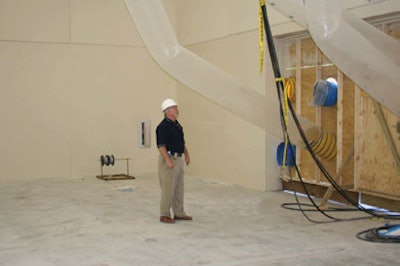
The construction industry has long been judged on its quality of work and ability to complete projects on schedule. One challenge often faced: a concrete slab with elevated moisture levels. The long time it takes for concrete slabs to dry can create delays, and of the various building materials, concrete can be one of the most vexing sources of moisture. Under average ambient conditions, a concrete slab poured within an enclosed building will dry at a rate of about one inch per month. The actual rate will differ based on the concrete batch ingredients (the mix design), curing procedures and ambient conditions—indoor and outdoor temperature, humidity and weather. Unless the excess moisture is dried, these problems could pop up later:
- Moisture migration to the surface, which can result in failure of adhesives, discoloration of flooring materials, blisters in coatings and warped flooring boards.
- Mold growth in other materials.
- Poor initial adhesion of flooring installed on the slab.
Amount of Excess Moisture
Concrete cures by hydration when water reacts with the cement powder, giving concrete its great strength. But the mix always contains more water than the hydration reaction requires. This has become even more prevalent with the use of lightweight aggregate, which tends to retain moisture.
In typical commercial floor slabs, there’s likely to be about 50 gallons of extra water in every cubic yard of the pour. This surplus must be removed after the concrete has cured. Relative humidity and weather are major contributors of additional moisture. Also, the materials used to construct the building retain moisture. Large amounts of water can be trapped in concrete wall blocks, and joint compound and paint emit large volumes of water as they dry.
A combination of these factors can create exceptionally high humidity levels inside a building. If the conditions are right, the interior atmosphere can even create fog and condensation that drips onto the slab.
In addition to slowing the construction schedule, excess moisture represents another major threat—mold. In order to grow, mold requires a food source, suitable temperatures and moisture. Of those, moisture is the only factor that is controllable.
The Importance of Low RH
Optimum indoor drying conditions require low relative humidity, regardless of temperature, with constant airflow over the slab surface. The use of a building’s HVAC system to establish low relative humidity is inadequate for several reasons, but the main one is that HVAC systems are engineered for temperature control, not moisture removal capacity.
Extra heating and cooling are commonly utilized at construction sites to control the ambient environment, but they also are not effective at significant moisture removal. In fact, heating the space with standard direct-fired construction heaters often will add moisture through combustion. Cooling equipment will make the space more comfortable but cannot provide the conditions necessary to provide significant concrete drying results. Therefore, using dehumidification equipment is often necessary to bring the RH to acceptable levels so the slab can dry. Using systems such as desiccant dehumidifiers will create low RH and dew points when drying air at a condition far from saturation or at low temperatures.
When you employ such a system, moisture travels from areas of high vapor pressure (within the slab) to the areas of lower vapor pressure that are being mechanically created (ambient condition)—essentially, the moisture vapor will be desorbed from the concrete into the air and will be pushed out of the space by air movement. The number of hourly air changes to be effective can vary greatly depending on the amount of moisture to be removed and the conditions present. Air change rates can fluctuate based on ceiling height, thickness of slab, tightness of envelope, type of vapor barrier (or lack of one), outside weather conditions and a host of other variables.
The use of dehumidifiers for drying concrete slabs is growing quickly, but the most popular method of preparing the slab for installing flooring is the use of a concrete sealer or some type of combination adhesive/moisture barrier. The decision to use a sealer/moisture barrier type of product or a dehumidification system is based on several factors, including budget, deadlines, severity of the problem, warranties and more. If the installer expects to install flooring in a few days, the use of a sealer is the only option, as the dehumidification process requires more time. If that time is available, however, the mechanical drying of the floor can be a good solution, as it removes the excess moisture instead of trapping it.
Measuring Moisture in a Slab
No matter what, be sure you measure the moisture in the slab. The most commonly used techniques are:
- RH Probe Test (ASTM F-2170): The U.S. construction market is just beginning to be comfortable with the quantitative method, popular in Europe, which measures relative humidity by drilling a hole in the concrete and leaving a probe in it for three days.
- Calcium Chloride (ASTM F-1869): This widely used quantitative test measures moisture in a thin upper layer of the slab. The test is based on the rate of absorption of moisture by the calcium chloride. Results are subject to temperature and humidity levels the day before the test results are viewed, which can produce different readings.
- Electronic Meters: A variety of meters measure conductivity.
Be sure to refer to the flooring manufacturer’s recommendations for expected moisture levels and the desired methods for monitoring.
































